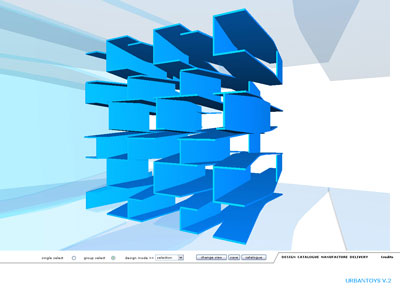 The Servo Urbantoys project diffuses the conventional roles of manufacturer, architect, designer and site visitor. The site is designed as an interface that provides tools for the design of architectural products, Urbantoys, via a series of manipulations of a digital model.
The Servo Urbantoys project diffuses the conventional roles of manufacturer, architect, designer and site visitor. The site is designed as an interface that provides tools for the design of architectural products, Urbantoys, via a series of manipulations of a digital model.
Operation
Urbantoys is a set of digitally instantiated products and instructions for their fabrication embedded in an interface intended for both viewing and extraction. Implicit in the word urban-toy is a fluctuation between an architectural scale and program and the scale of a toy or hand held object. It also connotes a digitally manipulable set of geometries, which are animated by the toy’s user and can be assembled computationally as a three-dimensional model or produced as a physical instantiation. The toy’s components are set in motion as a series of spatial parcels, which are activated by the user. The assembly of digital pieces is non-sequential proliferating into a series of models. The viewer is invited to act on a supplied catalogue of materials and infiltrate the design process. By submitting designs to and sampling designs from an online archive, the visitors’ designs are made available to other potential authors. Digitally catalogued urbantoys may be retrieved, fabricated and exhibited at a later event, turning the exhibition venue into a dynamic index of the design process as it is distributed among various agents. The interface also provides the possibility for the visitor to directly engage with a manufacturer by ordering a rapid prototype of the designed object.
Urbantoys v.2 was exhibited at the ReShape! exhibition curated by IASPIS at the Venice Biennale of the Arts in 2003. It is an upgraded version of the online design environment Urbantoys v.1 released in 2000 for the exhibition N2art curated by Peter Hagdahl. Part of a larger speculation on the incorporation of the user into design and production processes through the emergence of new interactive technologies, Urbantoys v.2 is an open-source interface through which outside authors customize a variety of generic design prototypes according to personal needs, interests, and constraints.
Physical installation
The temporary gallery space of the Reshape! show required a spatial setup for the digital design environment. A merged display wall, work place and light table operated as a platform for interaction, both literally in the digital design system, as well as through discussions between visitors.
Physical models of previous designs were displayed, and other components provided the context for the less informative digital interface. The Urbantoys v.2 featured a back-lit table connected to a wall, carrying models, and enabling visitors / users to gather around to handle the models and view product sheets of previous designs, providing a context for the digital browser.
The design environment allowed the visitor to move around in digital space, while manipulating the geometries in an intuitive manner. Simple instructions guided the user, indicating different potential transformations. The interface was connected to a separate database, allowing for the storage and retrieval of designs, names of authors and comments. This made possible the sampling of previous designs, to be altered and re-saved.
Development
The Urbantoys v.2 project used the Virtools game editor as a programming environment. The sampling of technology from other fields towards a new purpose requires the adaptation of techniques optimized for another agenda. This provides friction, but also opportunities.
During the Krets project development phase the software allowed for the sharing of behavioral scripts, enabling multiple developers to share the work on the prototype, which could also be continuously tested during the process. The Virtools-browser handled all interaction, providing behaviors to simple geometries resulting in a vast recombinatorial potential within the formative design concept.
Performance
The performative aspects of the project set up a new kind of relationship between designer, manufacturer and customer. The Urbantoys v.2 project explores the possibilities of using the gallery space as a platform for participatory design where the authorship of a set of environments is distributed and shared with the visitors. The visitor/ consumer of the piece is at the same time potentially a producer and author of designs that might be sampled by other visitors, as well as manufactured and exhibited at a later event. The audience involved in the consumption of the piece is at the same time the performers of a creative act. Krets, as authors and producers of the installation, will on the other hand act as consumers of the visitors saved designs when they are manufactured and exhibited.
Credits
Servo was invited by IASPIS to participate in the Reshape! sideshow to the 50th Venice Biennale. Krets was commissioned by Servo to develop the Urbantoys v.2 responsive browser, a re-development of the Urbantoys v.1 browser (2000).
Urbantoys v.2
Project leader:
Ulrika Karlsson, Servo
Urbantoys v.2 Krets design team:
Daniel Norell and Jonas Runberger
Database design:
Oskar Scheiwiller
Leave a Reply